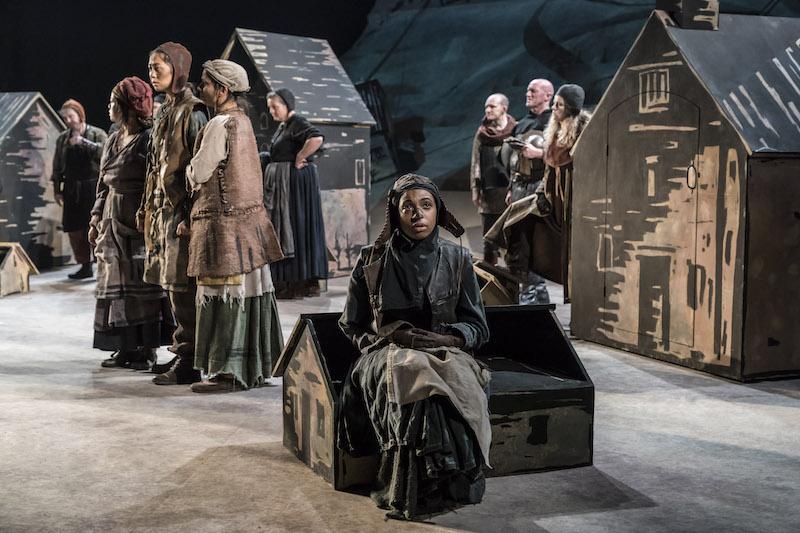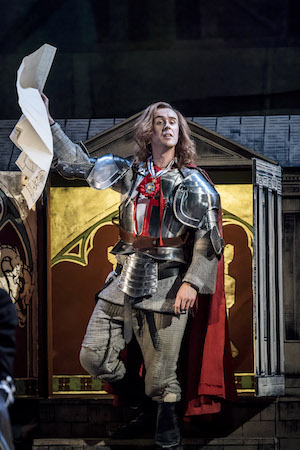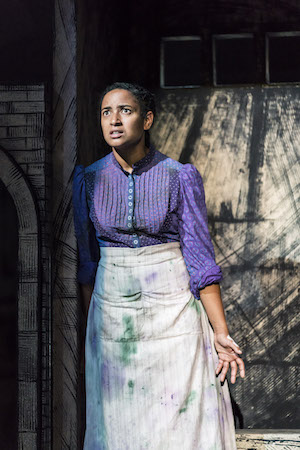Saint George and the Dragon, National Theatre review – a modern folk tale in the Olivier | reviews, news & interviews
Saint George and the Dragon, National Theatre review – a modern folk tale in the Olivier
Saint George and the Dragon, National Theatre review – a modern folk tale in the Olivier
England’s patron saint travels through time to demonstrate changing views of heroism

Bold and fearless are adjectives that might describe playwright Rory Mullarkey as accurately as any chivalrous knight. He made his name in 2013 when, at the age of 25, his play Cannibals, part of which was in Russian, took to the main stage at the Manchester Royal Exchange and went on to win the James Tait Black Prize.
 Saint George and the Dragon comes, in proper folk fashion, in three distinct parts. The first act might be mistaken for the National’s Christmas show. All the familiar fairy tale ingredients are there: a wandering knight who prizes liberty undertakes to rescue a maiden about to be eaten by a fire-breathing dragon. He is the underdog, but bravery and honesty prevail, he wins the lady and receives gratitude and adulation from the villagers relieved of their tyrant. But this knight began as a coward – having first failed to kill a different dragon, he fled. In John Heffernan’s engaging performance (pictured left) he is open-faced and innocent to the point of naiveté, while Elsa, his lady (Amaka Okafor, pictured below right), with plenty to say for herself, is no soppy maiden. There is a witty light heartedness about the whole thing: the intended victim complains about having to wear herbs in her hair in preparation for being eaten, and the dragon, taking human form for convenience, is camp in ’tache and diadem.
Saint George and the Dragon comes, in proper folk fashion, in three distinct parts. The first act might be mistaken for the National’s Christmas show. All the familiar fairy tale ingredients are there: a wandering knight who prizes liberty undertakes to rescue a maiden about to be eaten by a fire-breathing dragon. He is the underdog, but bravery and honesty prevail, he wins the lady and receives gratitude and adulation from the villagers relieved of their tyrant. But this knight began as a coward – having first failed to kill a different dragon, he fled. In John Heffernan’s engaging performance (pictured left) he is open-faced and innocent to the point of naiveté, while Elsa, his lady (Amaka Okafor, pictured below right), with plenty to say for herself, is no soppy maiden. There is a witty light heartedness about the whole thing: the intended victim complains about having to wear herbs in her hair in preparation for being eaten, and the dragon, taking human form for convenience, is camp in ’tache and diadem.
Director Lyndsey Turner (a previous Mullarkey collaborator) stages the duel brilliantly mainly by making the audience imagine it is happening in the sky out of sight. Two of the dragon’s three heads make spectacular stage-fall from above, however, and George reappears bloody and triumphant. The red-on-white English flag is formed by blood stains making a cross shape between the cake tins of the hero’s makeshift armour.
 Nothing is as much fun in the two remaining acts.
Nothing is as much fun in the two remaining acts.
The villagers take George’s advice to dream of their future while he disappears, summoned by the mysterious Brotherhood of Knights to kill more dragons. He returns after a year, but the changes of many generations have occurred in his absence and industrialisation has gripped the land. The dragon is now a vicious factory owner, standing for Victorian capitalism, and Elsa is to be hanged for stopping the machinery when a child worker is injured. She is rescued and George is again summoned while the villagers dream. He returns to a dystopian vision of modern Britain (or “an island much like our own") with its soulless tower blocks and street violence. The dragon is still lurking, but he claims that, being now part of all of us, he can no longer be so summarily killed. Is there any longer a place for heroes? Does Elsa – or anyone – need to be rescued or should we all take responsibility for ourselves? Is there any point in dreaming of the future? The ending is a long way from that breezy beginning.
Fluent Russian speaker Mullarkey has taken his cue from Evgeny Schwartz’s 1943 play The Dragon, an allegorical critique of Stalinism. Our muddling, faltering democracy lends itself less readily to similar treatment and there is a danger that we end up simply dispirited about the present, imagining some golden past. Hasn’t the dragon – and the hero – always been a part of us all?
The scope of the piece is daring and it is beautifully designed by Rae Smith whose medieval village of three-dimensional sketched houses becomes a land of factories and then of brutalist blocks. Mullarkey is undoubtedly talented, dealing in ideas and employing language with a confident flourish, but here the result is not equal to the ambition.
rating
Explore topics
Share this article
The future of Arts Journalism
You can stop theartsdesk.com closing!
We urgently need financing to survive. Our fundraising drive has thus far raised £49,000 but we need to reach £100,000 or we will be forced to close. Please contribute here: https://gofund.me/c3f6033d
And if you can forward this information to anyone who might assist, we’d be grateful.

Subscribe to theartsdesk.com
Thank you for continuing to read our work on theartsdesk.com. For unlimited access to every article in its entirety, including our archive of more than 15,000 pieces, we're asking for £5 per month or £40 per year. We feel it's a very good deal, and hope you do too.
To take a subscription now simply click here.
And if you're looking for that extra gift for a friend or family member, why not treat them to a theartsdesk.com gift subscription?
more Theatre
 Troilus and Cressida, Globe Theatre review - a 'problem play' with added problems
Raucous and carnivalesque, but also ugly and incomprehensible
Troilus and Cressida, Globe Theatre review - a 'problem play' with added problems
Raucous and carnivalesque, but also ugly and incomprehensible
 Clarkston, Trafalgar Theatre review - two lads on a road to nowhere
Netflix star, Joe Locke, is the selling point of a production that needs one
Clarkston, Trafalgar Theatre review - two lads on a road to nowhere
Netflix star, Joe Locke, is the selling point of a production that needs one
 Ghost Stories, Peacock Theatre review - spirited staging but short on scares
Impressive spectacle saves an ageing show in an unsuitable venue
Ghost Stories, Peacock Theatre review - spirited staging but short on scares
Impressive spectacle saves an ageing show in an unsuitable venue
 Hamlet, National Theatre review - turning tragedy to comedy is no joke
Hiran Abeyeskera’s childlike prince falls flat in a mixed production
Hamlet, National Theatre review - turning tragedy to comedy is no joke
Hiran Abeyeskera’s childlike prince falls flat in a mixed production
 Rohtko, Barbican review - postmodern meditation on fake and authentic art is less than the sum of its parts
Łukasz Twarkowski's production dazzles without illuminating
Rohtko, Barbican review - postmodern meditation on fake and authentic art is less than the sum of its parts
Łukasz Twarkowski's production dazzles without illuminating
 Lee, Park Theatre review - Lee Krasner looks back on her life as an artist
Informative and interesting, the play's format limits its potential
Lee, Park Theatre review - Lee Krasner looks back on her life as an artist
Informative and interesting, the play's format limits its potential
 Measure for Measure, RSC, Stratford review - 'problem play' has no problem with relevance
Shakespeare, in this adaptation, is at his most perceptive
Measure for Measure, RSC, Stratford review - 'problem play' has no problem with relevance
Shakespeare, in this adaptation, is at his most perceptive
 The Importance of Being Earnest, Noël Coward Theatre review - dazzling and delightful queer fest
West End transfer of National Theatre hit stars Stephen Fry and Olly Alexander
The Importance of Being Earnest, Noël Coward Theatre review - dazzling and delightful queer fest
West End transfer of National Theatre hit stars Stephen Fry and Olly Alexander
 Get Down Tonight, Charing Cross Theatre review - glitz and hits from the 70s
If you love the songs of KC and the Sunshine Band, Please Do Go!
Get Down Tonight, Charing Cross Theatre review - glitz and hits from the 70s
If you love the songs of KC and the Sunshine Band, Please Do Go!
 Punch, Apollo Theatre review - powerful play about the strength of redemption
James Graham's play transfixes the audience at every stage
Punch, Apollo Theatre review - powerful play about the strength of redemption
James Graham's play transfixes the audience at every stage
 The Billionaire Inside Your Head, Hampstead Theatre review - a map of a man with OCD
Will Lord's promising debut burdens a fine cast with too much dialogue
The Billionaire Inside Your Head, Hampstead Theatre review - a map of a man with OCD
Will Lord's promising debut burdens a fine cast with too much dialogue

Add comment